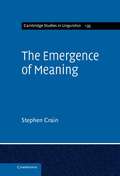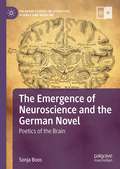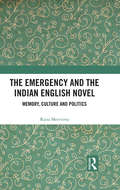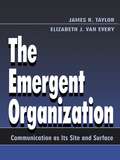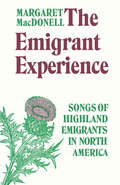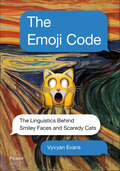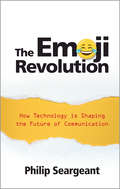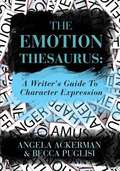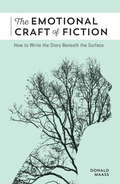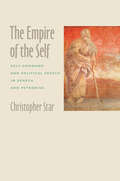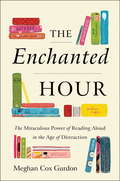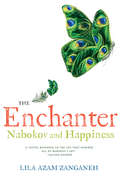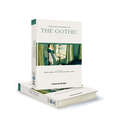- Table View
- List View
The Emergence of Meaning
by Stephen CrainOver the past forty years, scientists have developed models of human reasoning based on the principle that human languages and classical logic involve fundamentally different concepts and different methods of interpretation. In The Emergence of Meaning Stephen Crain challenges this view, arguing that a common logical nativism underpins human language and logical reasoning. The approach which Crain takes is twofold. Firstly, he uncovers the underlying meanings of logical expressions and logical principles that appear in typologically different languages – English and Mandarin Chinese – and he demonstrates that these meanings and principles directly correspond to the expressions and structures of classical logic. Secondly he reports the findings of new experimental studies which investigate how children acquire the logical concepts of these languages. A step-by-step introduction to logic and a comprehensive review of the literature on child language acquisition make this work accessible to those unfamiliar with either field.
The Emergence of Memory: Conversations with W. G. Sebald
by Lynne Sharon Schwartz W. G. SebaldWhen German author W. G. Sebald died in a car accident at the age of fifty-seven, the literary world mourned the loss of a writer whose oeuvre it was just beginning to appreciate. Through published interviews with and essays on Sebald, award-winning translator and author Lynne Sharon Schwartz offers a profound portrait of the writer, who has been praised posthumously for his unflinching explorations of historical cruelty, memory, and dislocation. With contributions from poet, essayist, and translator Charles Simic, New Republic editor Ruth Franklin, Bookworm radio host Michael Silverblatt, and more, The Emergence of Memory offers Sebald's own voice in interviews between 1997 up to a month before his death in 2001. Also included are cogent accounts of almost all of Sebald's books, thematically linked to events in the contributors' own lives.Contributors include Carole Angier, Joseph Cuomo, Ruth Franklin, Michael Hofmann, Arthur Lubow, Tim Parks, Michael Silverblatt, Charles Simic, and Eleanor Wachtel.
The Emergence of Neuroscience and the German Novel: Poetics of the Brain (Palgrave Studies in Literature, Science and Medicine)
by Sonja BoosThe Emergence of Neuroscience and the German Novel: Poetics of the Brain revises the dominant narrative about the distinctive psychological inwardness and introspective depth of the German novel by reinterpreting the novel’s development from the perspective of the nascent discipline of neuroscience, the emergence of which is coterminous with the rise of the novel form. In particular, it asks how the novel’s formal properties—stylistic, narrative, rhetorical, and figurative—correlate with the formation of a neuroscientific discourse, and how the former may have assisted, disrupted, and/or intensified the medical articulation of neurological concepts. This study poses the question: how does this rapidly evolving field emerge in the context of nineteenth century cultural practices and what were the conditions for its emergence in the German-speaking world specifically? Where did neuroscience begin and how did it broaden in scope? And most crucially, to what degree does it owe its existence to literature?
The Emergence of Phonology: Whole-word Approaches and Cross-linguistic Evidence
by Marilyn M. Vihman Tamar Keren-PortnoyHow well have classic ideas on whole-word phonology stood the test of time? Waterson claimed that each child has a system of their own; Ferguson and Farwell emphasised the relative accuracy of first words; Menn noted the occurrence of regression and the emergence of phonological systematicity. This volume brings together classic texts such as these with current data-rich studies of British and American English, Arabic, Brazilian Portuguese, Finnish, French, Japanese, Polish and Spanish. This combination of classic and contemporary work from the last 30 years presents the reader with cutting-edge perspectives on child language by linking historical approaches with current ideas such as exemplar theory and usage-based phonology and contrasting state-of-the-art perspectives from developmental psychology and linguistics. This is a valuable resource for cognitive scientists, developmentalists, linguists, psychologists, speech scientists and therapists interested in understanding how children begin to use language without the benefit of language-specific innate knowledge.
The Emergence of the Digital Humanities (Open Access)
by Steven E. JonesThe past decade has seen a profound shift in our collective understanding of the digital network. What was once understood to be a transcendent virtual reality is now experienced as a ubiquitous grid of data that we move through and interact with every day, raising new questions about the social, locative, embodied, and object-oriented nature of our experience in the networked world. In The Emergence of the Digital Humanities, Steven E. Jones examines this shift in our relationship to digital technology and the ways that it has affected humanities scholarship and the academy more broadly. Based on the premise that the network is now everywhere rather than merely "out there," Jones links together seemingly disparate cultural events—the essential features of popular social media, the rise of motion-control gaming and mobile platforms, the controversy over the "gamification" of everyday life, the spatial turn, fabrication and 3D printing, and electronic publishing—and argues that cultural responses to changes in technology provide an essential context for understanding the emergence of the digital humanities as a new field of study in this millennium. The Open Access version of this book, available at https://doi.org/10.4324/9780203093085, has been made available under a Creative Commons Attribution-Non Commercial-No Derivatives 4.0 license.
The Emergence of the Speech Capacity
by D. Kimbrough OllerRecent studies of vocal development in infants have shed new light on old questions of how the speech capacity is founded and how it may have evolved in the human species. Vocalizations in the very first months of life appear to provide previously unrecognized clues to the earliest steps in the process by which language came to exist and the processes by which communicative disorders arise. Perhaps the most interesting sounds made by infants are the uniquely human 'protophones' (loosely, 'babbling'), the precursors to speech. Kimbrough Oller argues that these are most profitably interpreted in the context of a new infrastructural model of speech. The model details the manner in which well-formed speech units are constructed, and it reveals how infant vocalizations mature through the first months of life by increasingly adhering to the rules of well-formed speech. He lays out many advantages of an infrastructural approach. Infrastructural interpretation illuminates the significance of vocal stages, and highlights clinically significant deviations, such as the previously unnoticed delays in vocal development that occur in deaf infants. An infrastructural approach also specifies potential paths of evolution for vocal communicative systems. Infrastructural properties and principles of potential communicative systems prove to be organized according to a natural logic--some properties and principles naturally presuppose others. Consequently some paths of evolution are likely while others can be ruled out. An infrastructural analysis also provides a stable basis for comparisons across species, comparisons that show how human vocal capabilities outstrip those of their primate relatives even during the first months of human infancy. The Emergence of the Speech Capacity will challenge psychologists, linguists, speech pathologists, and primatologists alike to rethink the ways they categorize and describe communication. Oller's infraphonological model permits provocative reconceptualizations of the ways infant vocalizations progress systematically toward speech, insightful comparisons between speech and the vocal systems of other species, and fruitful speculations about the origins of language.
The Emergency and the Indian English Novel: Memory, Culture and Politics
by Raita MerivirtaThis book examines the cultural trauma of the Indian Emergency through a reading of five seminal novels. It discusses the Emergency as an event that prompted the writing of several notable novels attempting to preserve the silenced and fading memory of its human rights violations and suspension of democracy. The author reads works by Salman Rushdie, Shashi Tharoor, Nayantara Sahgal and Rohinton Mistry in conjunction with government white papers, political speeches, memoirs, biographies and history. The book explores the betrayal of the Nehruvian idea of India and democracy by Indira Gandhi and analyses the political and cultural amnesia among the general populace in the decades following the Emergency. At a time when debates around freedom of speech and expression have become critical to literary and political discourses, this book will be of great interest to scholars and researchers of English literature, cultural studies, postcolonial studies, media studies, political studies, sociology, history and for general readers as well.
The Emergent Organization: Communication As Its Site and Surface (Routledge Communication Series)
by James R. Taylor Elizabeth J. Van EveryToday's organizations face a wide variety of challenges, including such contradictions as maintaining unity of action while becoming increasingly diverse. Even the definition of organization is changing and evolving. In this monograph, the authors apply their academic and professional experience to address the notion of "organization," setting forth communication as the essential modality for the constitution of organization--explaining how an organization can at the same time be both local and global, and how these properties which give organization continuity over time and across geographically dispersed situations also come to be manifested in the day-to-day of human interpersonal exchange. As a radical rethinking of the traditional discourse approaches in communication theory, this book develops a conceptual framework based on the idea that "organization" emerges in the mix of conversational and textual communicative activities that together construct organizational identity. Applying concepts from the philosophy of language, linguistics, semiotics, system design, sociology and management theory, the authors put forth a convincing argument demonstrating the materiality of language and its constructive role in organization and society.
The Emigrant Experience: Songs of Highland Emigrants in North America (The Royal Society of Canada Special Publications)
by Margaret MacDonellEvery man has a story to tell and this was no less true of the hundreds of emigrants from the Highlands and the Hebrides who crossed the Atlantic from the late eighteenth century to the early twentieth century to settle in North America. This selection of Scottish Gaelic songs brings to light the revealing and often touching poems of some twenty such emigrants. Focusing on themes of emigration and exile, their subjects range from the biblical motif of liberation from tyranny (pre-destined by the Creator who provided a land of bounty across the seas), to the happier future anticipated for his daughter by a loyalist fugitive in North Carolina; from a sense of security on the part of a clergyman settled in Pictou County after the disruption in his homeland, to the disenchantment of an emigrant to Manitoba who longed to move on to North Dakota. Their tone may be lyrical, elegaic, or satirical. Songs from various parts of the new world – the Carolinas, Nova Scotia, Prince Edward Island, Ontario, and the Canadian west – are included in Gaelic with a facing English translation. A short biography of each bard prefaces the selections attributed to him or her. Detailed notes provide a guide to sources and variant texts, elucidate obscure passages, and define the social and cultural context in which the songs originated. An appendix reproduces the tunes for nine of these songs.This is a book that will inform and entertain both the specialist and the general reader.
The Emoji Code: The Linguistics Behind Smiley Faces and Scaredy Cats
by Vyvyan EvansDrawing from disciplines as diverse as linguistics, cognitive science, psychology, and neuroscience, The Emoji Code explores how emojis are expanding communication and not ending it.For all the handwringing about the imminent death of written language, emoji—those happy faces and hearts—is not taking us backward to the dark ages of illiteracy. Every day 41.5 billion texts are sent by one quarter of the world, using 6 million emoji. Evans argues that these symbols enrich our ability to communicate and allow usto express our emotions and induce empathy—ultimately making us all better communicators.The Emoji Code charts the evolutionary origins of language, the social and cultural factors that govern its use, change, and development; as well as what it reveals about the human mind. In most communication, nonverbal cues are our emotional expression, signal our personality, and are our attitude toward our addressee. They provide the essential means of nuance and are essential to getting our ideas across. But in digital communication, these cues are missing, which can lead to miscommunication. The explosion of emojis in recent years has arisen precisely because it fulfills exactly these functions which are essential for communication but are otherwise absent in texts and emails. Evans persuasively argues that emoji add tone and an emotional voice and nuance, making us more effective communicators in the digital age.
The Emoji Revolution: How Technology is Shaping the Future of Communication
by Philip SeargeantWhere have emoji come from? Why are they so popular? What do they tell us about the technology-enhanced state of modern society? Far from simply being an amusing set of colourful little symbols, emoji are in the front line of a revolution in the way we communicate. As a form of global, image-based communication, they're a perfect example of the ingenuity and creativity at the heart of human interaction. But they're also a parable for the way that consumerism now permeates all parts of our daily existence, taking a controlling interest even in the language we use; and of how technology is becoming ever more entangled in our everyday lives. So how will this split-identity affect the way that online communication develops? Are emoji ushering in a bold new era of empathy and emotional engagement on the internet? Or are they a first sign that we're handing over the future of human interaction to the machines?
The Emotion Thesaurus: A Writer's Guide To Character Expression
by Angela Ackerman Becca PuglisiOne of the biggest problem areas for writers is conveying a character's emotions to the reader in a unique, compelling way. This book highlights 75 emotions and lists the possible body language cues, thoughts, and visceral responses for each. Readers can draw inspiration from character cues that range in intensity to match any emotional moment. The Emotion Thesaurus also tackles common emotion-related writing problems and provides methods to overcome them. This writing tool encourages writers to show, not tell emotion and is a creative brainstorming resource for any fiction project.
The Emotional Craft of Fiction: How to Write the Story Beneath the Surface
by Donald MaassEngage Your Readers with Emotion While writers might disagree over showing versus telling or plotting versus pantsing, none would argue this: If you want to write strong fiction, you must make your readers feel. The reader's experience must be an emotional journey of its own, one as involving as your characters' struggles, discoveries, and triumphs are for you. That's where The Emotional Craft of Fiction comes in. Veteran literary agent and expert fiction instructor Donald Maass shows you how to use story to provoke a visceral and emotional experience in readers. Topics covered include:emotional modes of writingbeyond showing versus tellingyour story's emotional worldmoral stakesconnecting the inner and outer journeysplot as emotional opportunitiesinvoking higher emotions, symbols, and emotional languagecascading changestory as emotional mirrorpositive spirit and magnanimous writingthe hidden current that makes stories moveReaders can simply read a novel...or they can experience it. The Emotional Craft of Fiction shows you how to make that happen.
The Emotional Life of Postmodern Film: Affect Theory's Other (Routledge Research in Cultural and Media Studies)
by Pansy DuncanEmotion and Postmodernism: is it possible to imagine an odder couple, stranger bedfellows, less bad company? The Emotional Life of Postmodern Film brings this unlikely pair into sustained dialogue, arguing that the interdisciplinary body of scholarship currently emerging under the rubric of "affect theory" may be unexpectedly enriched by an encounter with the field that has become its critical other. Across a series of radical re-reappraisals of canonical postmodern texts, from Fredric Jameson's Postmodernism to David Cronenberg's Crash, Duncan shows that the same postmodern archive that has proven resistant to strongly subject-based and object-oriented emotions, like anger and sadness, proves all too congenial to a series of idiosyncratic, borderline emotions, from knowingness, fascination and bewilderment to boredom and euphoria. The analysis of these emotions, in turn, promises to shake up scholarly consensus on two key counts. On the one hand, it will restructure our sense of the place and role of emotion in a critical enterprise that has long cast it as the stodgy, subjective sister of a supposedly more critically interesting and politically productive affect. On the other, it will transform our perception of postmodernism as a now-historical aesthetic and theoretical moment, teaching us to acknowledge more explicitly and to name more clearly the emotional life that energizes it.
The Emotionary: A Dictionary of Words That Don't Exist for Feelings That Do
by Eden SherA dictionary of words that don't exist for feelings that do written by The Middle actress Eden Sher and illustrated by acclaimed graphic novelist Julia Wertz.&“A must-read for bad, good and just plain complicated days.&” —Oprah.com All her life, Eden Sher has suffered from dyscommunicatia (n. the inability to articulate a feeling through words.). Then, one day, she decided that, whenever she had an emotion for which she had no word, she would make one up. The result of this is The Emotionary, which lives at the intersection of incredibly funny and very useful. Chock full of words you always wanted/never knew you needed, often accompanied by illustrations of hilarious and all-too-familiar situations, The Emotionary will be a cherished tool for you or the world-class feelings-haver in your life. At long last, all your complicated feelings can be put into words, so you can recognize them for what they are, speak their names aloud, and move on. Finally!
The Emotions of the Ancient Greeks
by David KonstanIt is generally assumed that whatever else has changed about the human condition since the dawn of civilization, basic human emotions - love, fear, anger, envy, shame - have remained constant. David Konstan, however, argues that the emotions of the ancient Greeks were in some significant respects different from our own, and that recognizing these differences is important to understanding ancient Greek literature and culture.With The Emotions of the Ancient Greeks, Konstan reexamines the traditional assumption that the Greek terms designating the emotions correspond more or less to those of today. Beneath the similarities, there are striking discrepancies. References to Greek 'anger' or 'love' or 'envy,' for example, commonly neglect the fact that the Greeks themselves did not use these terms, but rather words in their own language, such as orgê and philia and phthonos, which do not translate neatly into our modern emotional vocabulary. Konstan argues that classical representations and analyses of the emotions correspond to a world of intense competition for status, and focused on the attitudes, motives, and actions of others rather than on chance or natural events as the elicitors of emotion. Konstan makes use of Greek emotional concepts to interpret various works of classical literature, including epic, drama, history, and oratory. Moreover, he illustrates how the Greeks' conception of emotions has something to tell us about our own views, whether about the nature of particular emotions or of the category of emotion itself.
The Emperor and the Army in the Later Roman Empire, AD 235-395
by Mark HebblewhiteWith The Emperor and the Army in the Later Roman Empire, AD 235–395 Mark Hebblewhite offers the first study solely dedicated to examining the nature of the relationship between the emperor and his army in the politically and militarily volatile later Roman Empire. Bringing together a wide range of available literary, epigraphic and numismatic evidence he demonstrates that emperors of the period considered the army to be the key institution they had to mollify in order to retain power and consequently employed a range of strategies to keep the troops loyal to their cause. Key to these efforts were imperial attempts to project the emperor as a worthy general (imperator) and a generous provider of military pay and benefits. Also important were the honorific and symbolic gestures each emperor made to the army in order to convince them that they and the empire could only prosper under his rule.
The Empire Writes Back: Theory and Practice in Post-Colonial Literatures (New Accents)
by Bill Ashcroft Helen Tiffin Gareth GriffithsThe experience of colonization and the challenges of a post-colonial world have produced an explosion of new writing in English. This diverse and powerful body of literature has established a specific practice of post-colonial writing in cultures as various as India, Australia, the West Indies and Canada, and has challenged both the traditional canon and dominant ideas of literature and culture. The Empire Writes Back was the first major theoretical account of a wide range of post-colonial texts and their relation to the larger issues of post-colonial culture, and remains one of the most significant works published in this field. The authors, three leading figures in post-colonial studies, open up debates about the interrelationships of post-colonial literatures, investigate the powerful forces acting on language in the post-colonial text, and show how these texts constitute a radical critique of Eurocentric notions of literature and language. This book is brilliant not only for its incisive analysis, but for its accessibility for readers new to the field. Now with an additional chapter and an updated bibliography, The Empire Writes Back is essential for contemporary post-colonial studies.
The Empire of the Self: Self-Command and Political Speech in Seneca and Petronius
by Christopher StarChristopher Star uncovers significant points of contact between Seneca and Petronius, two important Roman writers long thought to be antagonists.In The Empire of the Self, Christopher Star studies the question of how political reality affects the concepts of body, soul, and self. Star argues that during the early Roman Empire the establishment of autocracy and the development of a universal ideal of individual autonomy were mutually enhancing phenomena. The Stoic ideal of individual empire or complete self-command is a major theme of Seneca’s philosophical works. The problematic consequences of this ideal are explored in Seneca’s dramatic and satirical works, as well as in the novel of his contemporary Petronius. Star examines the rhetorical links between these diverse texts. He also demonstrates a significant point of contact between two writers generally thought to be antagonists—the idea that imperial speech structures reveal the self.
The Empire's Old Clothes: What the Lone Ranger, Babar, and Other Innocent Heroes Do to Our Minds
by Ariel DorfmanIn this powerful cultural critique, Ariel Dorfman explores the political and social implications of the smiling faces that inhabit familiar books, comics, and magazines. He reveals the ideological messages conveyed in works of popular culture such as the Donald Duck comics, the Babar children's books, and Reader's Digest magazine. The Empire's Old Clothes was widely praised when it was first published in 1983. This edition, including a new preface by the author, makes a contemporary classic newly available.
The Enchanted Boot: Italian Fairy Tales and Their Tellers (The Donald Haase Series in Fairy-Tale Studies)
by Prof. Nancy L. CanepaThis comprehensive collection of Italian tales in English encourages a revisitation of the fairy-tale canon in light of some of the most fascinating material that has often been excluded from it. In the United States, we tend to associate fairy tales with children and are most familiar with the tales of the Brothers Grimm, Hans Christian Anderson, and Disney. But the first literary fairy tales appeared in Renaissance Italy, and long before the Grimms there was already a rich and sophisticated tradition that included hundreds of tales, including many of those today considered "classic." The authors featured in this volume have, over the centuries, explored and interrogated the intersections between elite and popular cultures and oral and literary narratives, just as they have investigated the ways in which fairy tales have been and continue to be rewritten as expressions of both collective identities and individual sensibilities. The fairy tale in its Italian incarnations provides a striking example of how this genre is a potent vehicle for expressing cultural aspirations and anxieties as well as for imagining different ways of narrating shared futures.
The Enchanted Hour: The Miraculous Power of Reading Aloud in the Age of Distraction
by Meghan Cox Gurdon'As soon as I began to read, I was filled with that kind of engrossed blossoming that happens somewhere inside of you when you start a really nourishing book.' - Pandora SykesA conversation-changing look at the social, familial, neurological, and psychological benefits of reading aloud, especially for parents and children. A miraculous alchemy occurs when one person reads to another, transforming the simple stuff of a book, a voice, and a bit of time into complex and powerful fuel for the heart, brain, and imagination. Grounded in the latest neuroscience and behavioural research, and drawing widely from literature, The Enchanted Hour explains the dazzling cognitive and social-emotional benefits that await children who are read to, whatever their class, nationality or family background. Meghan Cox Gurdon argues that this ancient practice is a fast-working antidote to the fractured attention spans, atomized families and unfulfilling ephemera of the tech era, helping to replenish what our devices are leaching away. For everyone, reading aloud engages the mind in complex narratives; for children, it's an irreplaceable gift that builds vocabulary, fosters imagination, and kindles a lifelong appreciation of language, stories and pictures.Bringing together the latest scientific research, practical tips, and reading recommendations, The Enchanted Hour will both charm and galvanize, inspiring readers to share this invaluable, life-altering tradition with the people they love most.
The Enchanted Screen: The Unknown History of Fairy-Tale Films
by Jack ZipesThe Enchanted Screen: The Unknown History of Fairy-Tale Films offers readers a long overdue, comprehensive look at the rich history of fairy tales and their influence on film, complete with the inclusion of an extensive filmography compiled by the author. With this book, Jack Zipes not only looks at the extensive, illustrious life of fairy tales and cinema, but he also reminds us that, decades before Walt Disney made his mark on the genre, fairy tales were central to the birth of cinema as a medium, as they offered cheap, copyright-free material that could easily engage audiences not only though their familiarity but also through their dazzling special effects. Since the story of fairy tales on film stretches far beyond Disney, this book, therefore, discusses a broad range of films silent, English and non-English, animation, live-action, puppetry, woodcut, montage (Jim Henson), cartoon, and digital. Zipes, thus, gives his readers an in depth look into the special relationship between fairy tales and cinema, and guides us through this vast array of films by tracing the adaptations of major fairy tales like "Little Red Riding Hood," "Cinderella," "Snow White," "Peter Pan," and many more, from their earliest cinematic appearances to today. Full of insight into some of our most beloved films and stories, and boldly illustrated with numerous film stills, The Enchanted Screen, is essential reading for film buffs and fans of the fairy tale alike.
The Enchanter: Nabokov and Happiness
by Lila Azam ZanganehDiscovering happiness in reading the work of an extraordinary writer. The protagonist of Vladimir Nabokov's The Gift playfully dreamed of writing "A Practical Handbook: How to Be Happy." Now, Nabokov's own creative reader Lila Azam Zanganeh lends life to this vision with sly sophistication and ebullient charm, as she shares the delirious joy to be found in reading the masterpieces of "the great writer of happiness." Plunging into the enchanted and luminous worlds of Speak, Memory; Ada, or Ardor; and the infamous Lolita, Azam Zanganeh seeks out the Nabokovian experience of time, memory, sexual passion, nature, loss, love in all its forms, and language in all its allusions. She explores Nabokov's geography-from his Russian childhood to the landscapes of "his" America-suffers encounters with his beloved "nature," hallucinates an interview with the master, and seeks the "crunch of happiness" in his singular vocabulary. This beautifully illuminated book will both reignite the passion of experienced Nabokovians and lure the innocent reader to a well of delights as yet unseen.
The Encyclopedia of the Gothic, 2 Volumes
by Andrew Smith William Hughes David PunterThe Encylopedia of the Gothic features a series of newly-commissioned essays from experts in Gothic studies that cover all aspects of the Gothic as it is currently taught and researched, along with the development of the genre and its impact on contemporary culture. Comprises over 200 newly commissioned entries written by a stellar cast of over 130 experts in the field Arranged in A-Z format across two fully cross-referenced volumes Represents the definitive reference guide to all aspects of the Gothic Provides comprehensive coverage of relevant authors, national traditions, critical developments, and notable texts that define, shape, and inform the genre Extends beyond a purely literary analysis to explore Gothic elements of film, music, drama, art, and architecture. Explores the development of the genre and its impact on contemporary culture
